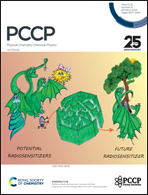Electron stimulated desorption from condensed benzene
Abstract
The electron induced dissociation of condensed benzene (C6H6) in thin films deposited on a Pt substrate is investigated by electron stimulated desorption (ESD) of anions and cations. The desorbed yields are recorded as a function of incident electron energy in the range of 10 to 950 eV for a fixed film thickness of 2 monolayers (ML) and for a fixed energy of 950 eV, as well as a function of film thickness from 0.5 to 8 monolayers (ML) for anions, and from 0.5 to 12ML for cations. Both energy and thickness dependencies are discussed in terms of the three main mechanisms yielding positively and/or negatively charged fragments: dissociative electron attachment (DEA), dipolar dissociation (DD) and dissociative ionization (DI) processes. At the probed energies, DD is the major mechanism, while DEA is predominantly induced by secondary electrons from the Pt substrate. Desorption of the parent positive ion is strongly suppressed. Similar qualitative behaviours are observed for the energy dependence of both anion and cation ESD yields, while some discrepancies exist in the thickness dependence, including a very significant systematic magnitude difference found between such ions formation. An estimation of the effective DD cross-section including the desorption probability is obtained. Feasible mechanisms behind the observed energy and thickness dependences for anion and cation yields are proposed. These results highlight the need for further investigations to better understand the underlying processes of electron induced dissociation in condensed matter.

- This article is part of the themed collection: 2024 PCCP HOT Articles


 Please wait while we load your content...
Please wait while we load your content...